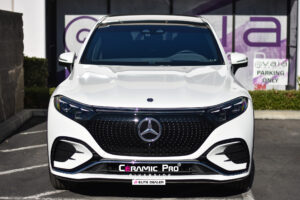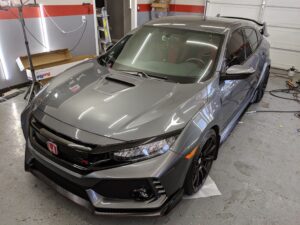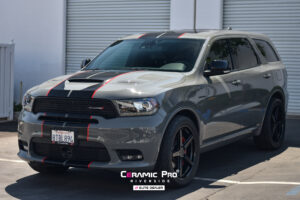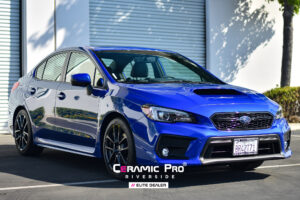When it comes to protecting your vehicle’s paintwork, traditional methods like waxing and polishing have long been the norm. In recent years, a revolutionary solution has taken the automotive world by storm – ceramic coating. This advanced protective coating offers unparalleled durability, longevity, and aesthetics, making it a game-changer for vehicle enthusiasts.
What is ceramic coating?
Ceramic coating, also known as nano-ceramic coating or glass coating, is a liquid polymer that forms a strong bond with a vehicle’s paintwork. It creates a protective layer that shields the paint from external elements such as UV rays, dirt, chemicals, and minor scratches. Unlike traditional wax or sealant, the ceramic coating provides a long-lasting barrier that can withstand harsh conditions.
Benefits of ceramic coating
Ceramic coating offers numerous benefits over traditional methods. It provides exceptional protection against UV rays, which can cause paint fading and oxidation. The ceramic coating enhances a vehicle’s hydrophobic properties, allowing water and other liquids to bead and roll off the surface effortlessly. This property makes cleaning and maintenance significantly easier.
How does ceramic coating work?
The science behind the ceramic coating
Ceramic coatings are based on nanotechnology, which involves the manipulation of matter at the atomic and molecular levels. These coatings utilize nanoparticles that bond with the surface, creating a semi-permanent protective layer. The nanoparticles fill in microscopic imperfections in the paint, resulting in a smoother and more reflective surface.
Nanotechnology in ceramic coatings
Nanotechnology plays a crucial role in ceramic coatings’ performance. The tiny particles used in these coatings form a dense and durable layer that enhances scratch resistance. The microscopic size of the nanoparticles ensures they can penetrate and bond with the surface effectively, providing long-lasting protection.
Advantages of ceramic coating
Enhanced durability and protection
One of the significant advantages of ceramic coating is its exceptional durability. Once applied, it forms a protective barrier that shields the paint from scratches, bird droppings, tree sap, and other environmental contaminants. This durability ensures the vehicle’s paintwork remains intact and prevents the need for frequent touch-ups or repainting.
UV protection and heat resistance
Another crucial benefit of ceramic coating is its ability to protect against harmful UV rays. Prolonged exposure to the sun’s rays can cause paint fading and oxidation. Ceramic coatings contain UV inhibitors that prevent UV-induced damage, keeping the paint vibrant and fresh. Furthermore, ceramic coatings exhibit excellent heat resistance, reducing the risk of heat-related paint damage.
Chemical resistance and easy maintenance
Ceramic coatings offer exceptional chemical resistance, protecting the vehicle’s paint from corrosive substances like acidic rain, bird droppings, and bug splatters. The coating acts as a barrier, preventing these chemicals from etching into the paintwork. The hydrophobic nature of ceramic coatings makes them highly resistant to water spotting and staining, ensuring your vehicle looks pristine with minimal effort.
Improved aesthetics and gloss
Applying a ceramic coating to a vehicle not only offers protection but also enhances its appearance. The reflective properties of the coating create a deep, glossy finish that intensifies the color and shine of the paint. The smoothness of the coating also minimizes the accumulation of dirt and grime, resulting in a cleaner and more eye-catching vehicle.
Application process
Surface Preparation
Before applying the ceramic coating, thorough surface preparation is essential. This process involves washing, decontaminating, and polishing the vehicle’s paint to remove any impurities or imperfections. It ensures the coating bonds effectively with the surface, maximizing its durability and performance.
Applying the ceramic coating
The actual application of ceramic coating requires attention to detail. The coating is carefully applied to the vehicle’s paintwork in small sections, ensuring even coverage. It is essential to follow the manufacturer’s instructions and allow sufficient curing time between layers if multiple coats are recommended.
Curing and drying
Once the ceramic coating is applied, it needs time to cure and dry. This process allows the coating to form a strong bond with the paintwork. The curing time may vary depending on the specific product used, but it typically ranges from a few hours to a couple of days. It’s crucial to avoid exposing the vehicle to water or extreme weather conditions during this curing period.
Longevity and maintenance
How long does ceramic coating last?
The longevity of ceramic coating depends on several factors, including the quality of the coating and the maintenance routine. High-quality ceramic coatings can last anywhere from two to five years or even longer with proper care. Regular maintenance and avoiding harsh chemicals or abrasive washing techniques can significantly extend the coating’s lifespan.
Maintenance tips for ceramic-coated vehicles
To maximize the benefits of ceramic coating riverside ca, it’s essential to follow a proper maintenance routine. This includes regular washing with a pH-neutral shampoo, using a microfiber wash mitt or sponge, and drying with a soft, lint-free towel. Avoid automatic car washes with abrasive brushes and harsh chemicals, as they can degrade the coating over time.
Ceramic coating vs. traditional waxing
Key differences
While traditional waxing and ceramic coating both aim to protect a vehicle’s paintwork, they differ significantly in their longevity and durability. Wax provides temporary protection and needs to be reapplied frequently, while ceramic coating offers long-term defense against various elements. Ceramic coatings create a harder and more resilient barrier compared to wax, making them better equipped to withstand scratches and environmental contaminants.
Long-term cost-effectiveness
Although ceramic coating may have a higher upfront cost than traditional waxing, its long-term cost-effectiveness becomes evident. With wax, frequent reapplication, and maintenance expenses can add up over time. In contrast, ceramic coating’s durability and longevity reduce the need for regular reapplication, making it a more cost-effective option in the long run.
Frequently asked questions
How is ceramic coating different from paint protection film?
Ceramic coating and paint protection film (PPF) are two distinct methods of protecting a vehicle’s paint. The ceramic coating forms a transparent layer that bonds with the paint, while PPF is a physical film applied to the surface. The ceramic coating enhances the paint’s gloss and provides chemical resistance, while PPF offers incredible protection against rock chips, scratches, and minor impacts.
Can the ceramic coating be applied to any vehicle?
Yes, ceramic coating can be applied to various types of vehicles, including cars, motorcycles, trucks, and even boats. It is suitable for both new and used vehicles, offering protection and enhancing the aesthetics of any paintwork.
Is ceramic coating a DIY job?
While it’s possible to apply the ceramic coating as a DIY project, it’s recommended to seek professional assistance for optimal results. Professional detailers have the necessary expertise, tools, and controlled environments to ensure proper application and maximize the coating’s performance.
Can ceramic coating prevent scratches?
While ceramic coating provides an additional layer of protection, it does not make a vehicle scratch-proof. The hardness of the coating can make the paintwork more resistant to minor scratches caused by daily use or washing, reducing their visibility and impact.
How often should ceramic coating be applied?
The frequency of ceramic coating application depends on the specific product used and the environmental conditions the vehicle is exposed to. Ceramic coatings can last several years, but it’s advisable to consult the manufacturer’s recommendations and consider regular maintenance to preserve the coating’s effectiveness.
Unleashing the potential of ceramic coating revolutionizes vehicle protection. Its advanced technology and exceptional performance provide unmatched durability, UV protection, chemical resistance, and enhanced aesthetics. By choosing a ceramic coating, you ensure your vehicle maintains its pristine appearance while benefiting from long-term cost savings. Invest in ceramic coating to safeguard your vehicle’s paintwork and enjoy unparalleled protection for years to come.






